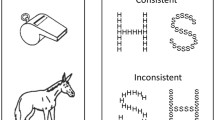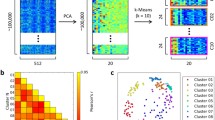Abstract
When humans process visual stimuli, global information often takes precedence over local information. In contrast, some recent studies have pointed to a local precedence effect in both pigeons and nonhuman primates. In the experiment reported here, we compared the speed of acquisition of two different categorizations of the same four geometric figures. One categorization was on the basis of a local feature, the other on the basis of a readily apparent global feature. For both humans and pigeons, the global-feature categorization was acquired more rapidly. This result reinforces the conclusion that local information does not always take precedence over global information in nonhuman animals.


Similar content being viewed by others
References
Cavoto KK, Cook RG (2001) Cognitive precedence for local information in hierarchical stimulus processing by pigeons. J Exp Psychol Anim Behav Process 27:3–16
Cerella J (1980) The pigeons’ analysis of pictures. Pattern Recogn 12:1–6
Deruelle C, Fagot J (1998) Visual search for global/local stimulus features in humans and baboons. Psychonomic Bull Rev 5:476–481
Dukette D, Stiles J (2001) The effects of stimulus density on children’s analysis of hierarchical patterns. Dev Sci 4:233–251
Fagot J, Deruelle C (1997) Processing of global and local visual information and hemispheric specialization in humans (Homo sapiens) and baboons (Papio papio). J Exp Psychol Hum Percept Perform 32:429–442
Fagot J, Tomonaga M (1999) Global and local processing in humans (Homo sapiens) and chimpanzees (Pan troglodytes): use of a visual search task with compound stimuli. J Comp Psychol 113:3–12
Fagot J, Tomonaga M (2001) Effects of element separation on perceptual grouping by humans (Homo sapiens) and chimpanzees (Pan troglodytes): perception of Kanizsa illusory figures. Anim Cogn 4:171–177
Fremouw T, Herbranson WT, Shimp CP (1998) Priming of attention to local or global levels of visual analysis. J Exp Psychol Anim Behav Process 24:278–290
Fremouw T, Herbranson WT, Shimp CP (2002) Dynamic shifts of pigeon local/global attention. Anim Cogn 5:233–243
Garner WR (1974) The processing of information and structure. Erlbaum, Hillsdale, NJ
Garner WR (1978) Aspects of a stimulus: features, dimensions, and configurations. In: Tighe TJ, Shepp BE (eds) Perception, cognition, and development: interactional analysis. Erlbaum, Hillsdale, N.J., pp 99–133
Grice GR, Canham L, Boroughs JM (1983) Forest before trees? It depends where you look. Percept Psychophys 3:121–128
Herrnstein RJ, Loveland DH, Cable C (1976) Natural concepts in pigeons. J Exp Psychol Anim Behav Process 2: 285–302
Hopkins WD, Washburn DA (2002) Matching visual stimuli on the basis of global and local features by chimpanzees (Pan troglodytes) and rhesus monkeys (Macaca mulatta). Anim Cogn 5:27–31
Kelly DM, Bischof WF, Douglas RW, Spetch ML (2001) Detection of Glass patterns by pigeons and humans: implication for differences in higher-level processing. Psychol Sci 12:338–342
Kimchi R (1988) Selective attention to global and local levels in the comparison of hierarchical patterns. Percept Psychophys 43:189–198
Kimchi R, Palmer SE (1985) Separability and integrality of global and local levels of hierarchical patterns. J Exp Psychol Hum Percept Perform 11:673–688
Kinchla RA, Wolfe JM (1979) The order of visual processing: “top down”, “bottom up” or “middle-out.” Percept Psychophys 25:225–231
Lombardi CM, Delius JD (1990) Size invariance in visual pattern recognition by pigeons. In: Commons ML, Herrnstein RJ, Kosslyn S, Mumford D (eds) Quantitative analysis of behavior, vol 8. Behavioral approaches to pattern recognition and concept formation. Ballinger, Cambridge, Mass., pp 41–65
Martin M (1979) Local and global processing: the role of sparsity. Mem Cogn 7:476–484
Navon D (1977) Forest before trees: the precedence of global features in visual perception. Cogn Psychol 9:353–383
Navon D (1981) The forest revisited: more on global precedence. Psychol Res 43:1–32
Navon D (1983) How many trees does it take to make a forest? Perception 12:239–254
Spinozzi G, De Lillo C, Truppa V (2003) Global and local processing of hierarchical visual stimuli in tufted capuchin monkeys (Cebus apella). J Comp Psychol 117:15–23
Acknowledgements
We are grateful to David Taylor for the construction of the test chambers, to Peter Goodes for the maintenance of the test chambers and to Catriona Ryan for technical support. Housing of the animals and conduct of the experiments conformed to the requirements of the UK Animals (Scientific Purposes) Act, 1986 and University and departmental guidelines. Departmental ethical requirements in respect of human participants were followed.
Author information
Authors and Affiliations
Corresponding author
Rights and permissions
About this article
Cite this article
Goto, K., Wills, A.J. & Lea, S.E.G. Global-feature classification can be acquired more rapidly than local-feature classification in both humans and pigeons. Anim Cogn 7, 109–113 (2004). https://doi.org/10.1007/s10071-003-0193-8
Received:
Revised:
Accepted:
Published:
Issue Date:
DOI: https://doi.org/10.1007/s10071-003-0193-8




